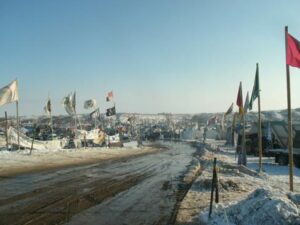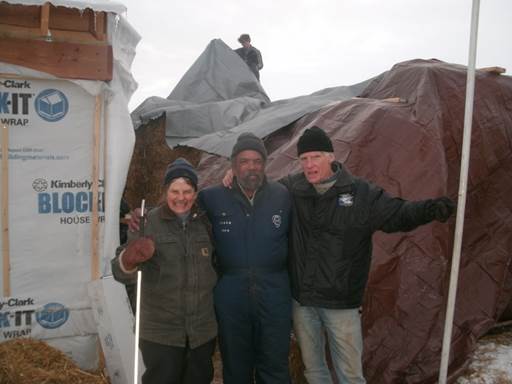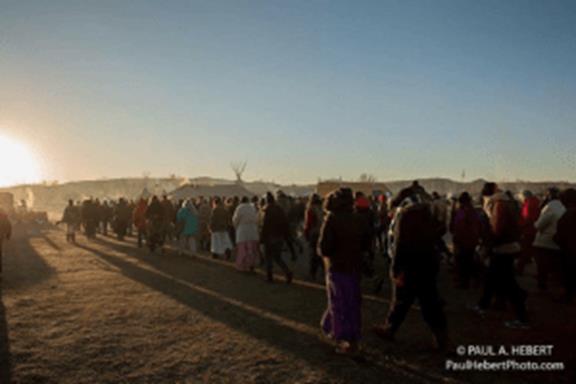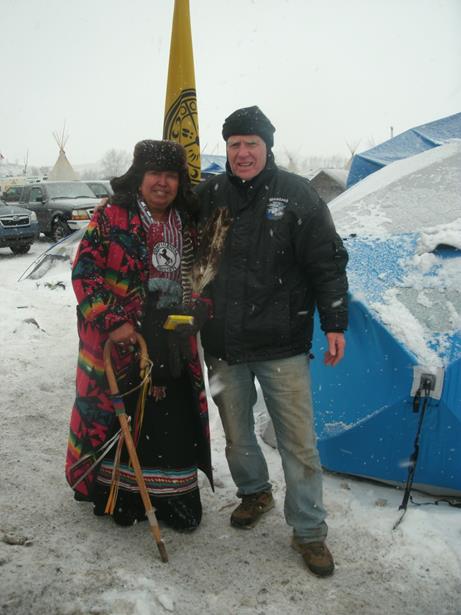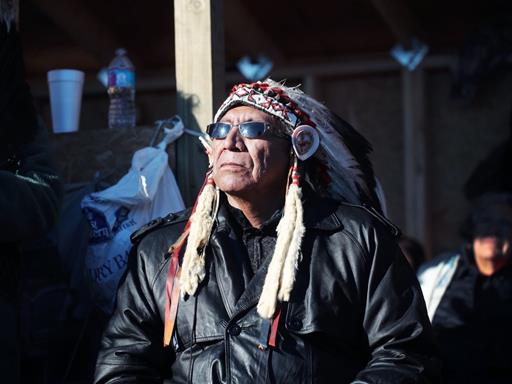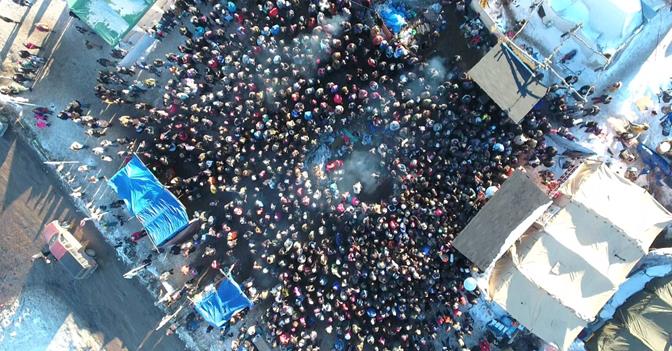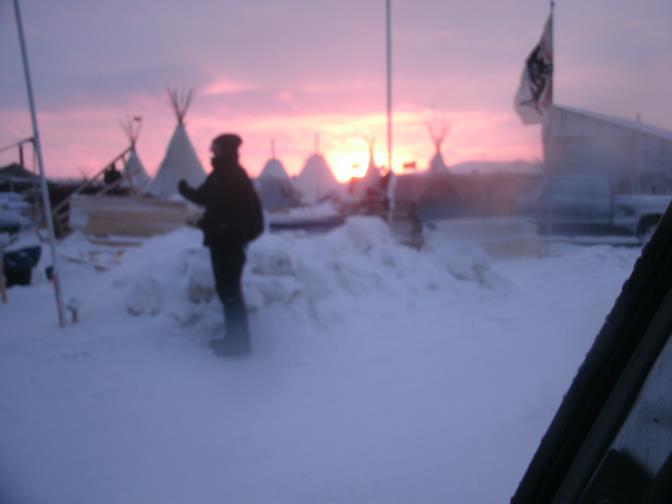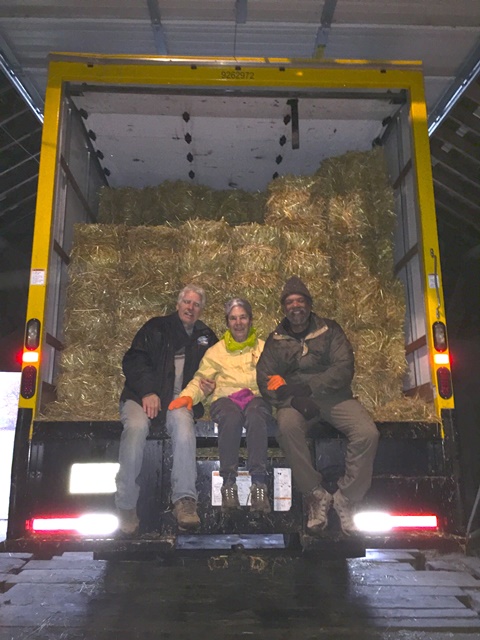
Brayton, Hattie and Tim after loading the straw bales
As I read the sign, “Entering Standing Rock Reservation” I feel a jolt of excitement—like seeing pack of wolves with all their primitive wonder. The road becomes two arrow-straight lanes, along a flat, arid landscape, void of trees. We now inhabit the snow-laden and frigid cold country of the Dakotas. We soon pass another sign that reads, “Cannon Ball.” Tim knows the encampment is a mile further up over the next hill.
We round that next bend and there it is: “Oceti Sakowin Camp,” nestled in the flat, barren wilderness. Oceti Sakowin is a Sioux name meaning “Seven Council Fires.” Like a Bedoin tribe in snow covered badlands, this Camp looks to me like the Promised Land. Imagine an area a mile and a half square area along a river bed, with thousands of tents, yurts, vans and trucks housing roughly 7,000 people. We approach behind 30 cars and trucks lined up to get in. The sun is shining. The gatekeeper looks up at us and says: “Welcome Home.” Emotions start welling. We inform the gatekeeper that Jimmy Betts, who works construction at Standing Rock had requested bales of straw to insulate the tents. We are directed to the construction site where carpenters are feverishly building 2 X 4 walls to convert into housing sheds. I meet up with Eric who is heading up the entire building project with busy maxed-out people around him, constantly talking. Personable and funny, Eric greets us and tells me to off-load the straw bales on the other side of the construction shed. He shares with me that he arrived a month and a half ago, prepared to stay a week, then got into building and stayed six weeks. “I can’t leave now, he says, “I know too much! When life gets crazy here and egos get too large, the Native Elders tell us to humble ourselves.” We smile at each other and admit that our “can-do white guy blood” makes humility difficult.
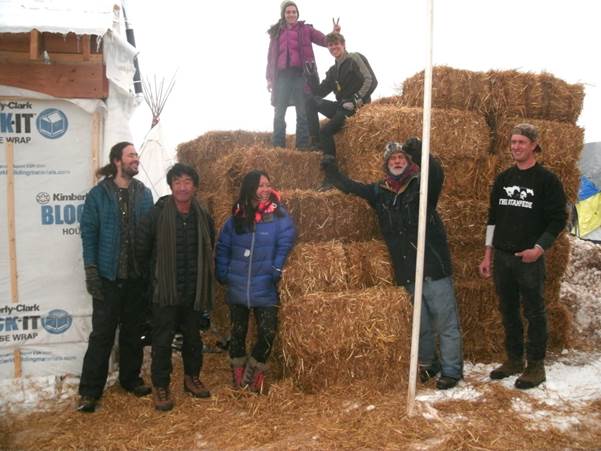 We begin to unload the bales to a tremendous buzz of excitement. The construction site is right in the middle of the camp and hundreds of people are milling up and down Flagg Road, the main road through the camp, lined by Native Flags representing 250 tribes supporting Standing Rock. Tim and Nelia feverishly unload the truck, while I start recruiting 10 or so young people, all from different parts of the country, to stack the bales.
We begin to unload the bales to a tremendous buzz of excitement. The construction site is right in the middle of the camp and hundreds of people are milling up and down Flagg Road, the main road through the camp, lined by Native Flags representing 250 tribes supporting Standing Rock. Tim and Nelia feverishly unload the truck, while I start recruiting 10 or so young people, all from different parts of the country, to stack the bales.
Sky, a young lad from Wisconsin, directs the stacking project, while I recruit and take photos. Straw bales have a romantic, farm country wholesomeness that enlivens the commotion around the stacking. Elvis from Hudson, New York and Nora from Portland, Oregon, join us to cover the bales with tarps. People excitedly come and pick up mounds of loose straw and put in their orders for bales.
In the confusion of picture taking, I drop my gloves somewhere. My fingers are immediately numb. A local Native guy sees my need and ushers me to the clothing tent. The woman in charge tells me that more boxes than she can sort come into the post office daily, including all kinds of clothes. It soon becomes obvious that everyone who comes to this camp finds all the layers they need to keep warm. Now for a place to stay.
The Great State of Michigan
Tim parks the truck across from the “Michigan Tent.” Although we are not Michiganians and the tent seems full, he negotiates some floor space in one of Michigan’s two sleeping tents, next to the food tent where 30 or so people have dinner together. Someone generously offers two spaces for Tim and Nelia. I decide to look for other lodging. Carly serves dinner of venison soup and hamburger stew. She welcomes us outta-staters like we are kin. Steve, a Vietnam combat veteran and a real character, keeps everyone laughing. He too greets us like old friends. I limit my dinner to a few apples and oranges, some bottled water and saltines,
I leave for the main gathering place, the Sacred Fire Circle, to find lodging. This circle is called the “Sacred Fire of the Seven Councils.” The original Sioux Tribe was made of seven council fires, each fire representing individual bonds based on kinship, dialect and proximity. Sharing a common fire is one ritual that has always united the Sioux people. The prayer circle is the camp’s constant heartbeat, the fire always kept burning.
Oceti Sakowin, founded in the spring of 2016, is a ceremonial camp to hold a prayerful intention for protecting the sacred Missouri River waters threatened by the Dakota Access Pipeline. When I arrive at the Fire Circle, a Native Elder informs us that “this is the first time in 140 years that the Council fires have been lit to symbolize our unity to protect these sacred waters.”
As I walk into the sacred embrace of the burning fire, I am immediately surrounded by college students who have that “just arrived at Standing Rock” look in their eyes. I sit by the fire. Matt, from the Bay Area, immediately sits next to me, introduces himself and we start talking.
U.C. Berkeley College students sit down to my right. I share with them that our crew brought 238 straw bales from Massachusetts and that my wife and I live in a straw bale house located on our community grounds. Even for Berkeley students, they seemed stunned, their eyes wide with wonder. “You actually live like that?” they exclaim. This same scenario occurs over and over, and I am mystically transported back to the Agape’s own fire circle and its serenity, surrounded by college students during rural immersions we host at the community in Hardwick.
As I ask around the circle for tent space, almost everyone I query owns a small tent or will be sleeping in cars, trucks and vans. The word is that we are 7,000 strong with a thousand arriving today. 2000 vets are due over the weekend. It is 10 pm and people are still arriving and milling around the fire. I decide to head back to the Michigan tent and negotiate a 3 x 6 foot piece of floor in one of their 20 x 60 foot military issue, canvas tents that sleep 40.
I find a spot next to Bea, a Native Elder woman from Detroit, who seems to know everyone. I lie back to sleep with my toes almost hitting one of the two woodstoves. I know that, fully clothed with winter coat, I will be just “warm enough” on this cold, hard ground. Stoves need stoking every 3 hours. Just before dawn, I wake up to freezing cold. The fire has gone out. I hear the announcement of Morning Prayer on the camp loud speaker and make my way groggily in the dark to this most blessed of Fire Circles. One hundred of us pray standing in a circle. All prayer is done on our feet. Our Native leader encourages us: “Get up and pray every morning, and take the prayer through the day.” We pray together, in a soothing, mesmerizing hour of chant, song, and drumming exclusively Native-led, with intermittent testimony to tribal wisdom.
The chant and testimony continue literally throughout the entire day until 9 pm. I hover around one of the three warming fires that keep me toasty enough to carry on in single digit weather with high winds. I am next to a guy who reminds me of the biblical “Moses.” An intense-looking 70 year old man appearing painfully burned out and mentally ill, quietly chants something that sounds like Hebrew. He “holds court” sometimes very cogently, talking non-stop throughout the day about this and that. I would guess he is an Oceti Sakowin Camp resident in good standing. As I travel the Camp, I estimate 100 fires are burning inside the tents and the many outside gathering areas. Trucks arrive in a steady stream delivering wood. Michigan folks haul in 50 twenty foot logs from home, just for their use. This anthill of collective purpose has impressively good organization underneath. We were always just “warm enough.”
Looking At the Settler Colonialist Within
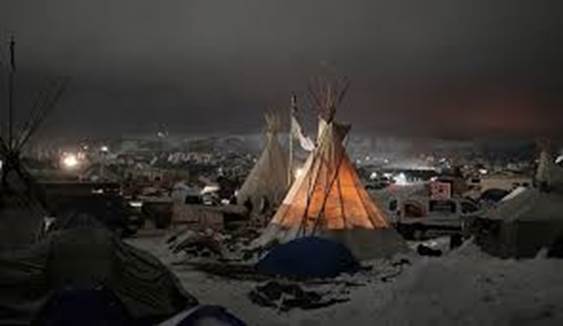 I meet with Tim and Nelia to attend the daily 9 am Orientation Meeting. The staff informs the 200 of us present that this is the largest orientation group Standing Rock has ever had. 2,000 or so Veterans are still making their way into the camp from all over the country. Event facilitator and spokesperson, Johnny Aberon, gives the opening talk. A tall, thin Native man in his 60’s with well-honed speaking skills, he covers how Standing Rock was born and shares that “the Council fires are burning for the first time in 140 years.” After he finishes, three young women take the mike–a Philipino-American, A Lakota Native from Standing Rock, and a white women from San Francisco. The three women spend two hours advising us on how to comport ourselves while living at the camp. As the women’s talks unfold, I feel their pain, the urgency of their message: 500 years of oppression of Native Americans. And then, the utter historic significance of so-called “white allies” of European descent, like me, making a pilgrimage to Standing Rock in 2016.
I meet with Tim and Nelia to attend the daily 9 am Orientation Meeting. The staff informs the 200 of us present that this is the largest orientation group Standing Rock has ever had. 2,000 or so Veterans are still making their way into the camp from all over the country. Event facilitator and spokesperson, Johnny Aberon, gives the opening talk. A tall, thin Native man in his 60’s with well-honed speaking skills, he covers how Standing Rock was born and shares that “the Council fires are burning for the first time in 140 years.” After he finishes, three young women take the mike–a Philipino-American, A Lakota Native from Standing Rock, and a white women from San Francisco. The three women spend two hours advising us on how to comport ourselves while living at the camp. As the women’s talks unfold, I feel their pain, the urgency of their message: 500 years of oppression of Native Americans. And then, the utter historic significance of so-called “white allies” of European descent, like me, making a pilgrimage to Standing Rock in 2016.
As the women speak, fighting back tears, I feel my own coming on. Approximately 4,000 or so “white allies” learn the lesson: our settler colonialist behavior is ingrained. The women recite the code of conduct here: prefer to listen, not to speak; to stand for prayer before and after all gatherings; to refrain from all criticism, opinion and gossip; to accept and follow what the Elders have established here as well-thought-out and trustworthy. Avoid settler, colonialist behavior, i.e., taking charge, taking over, looking to control, having everything figured out, quickly fixing everything that is wrong. Whew! I can feel too many of these impulses brewing within me as I listen.
We are also advised to refrain from unnecessary picture-taking and to “be sure to ask everyone, especially Natives, if you can take their picture.” Then we hear the sacred prohibition: no picture taking at any ceremony or prayer. I now feel awkward taking any photographs. Elders’ advice: get used to feeling uncomfortable as you adjust to Native ways, especially when noticing any take-over leadership inclinations inside you. But, we are also reminded that when we inevitably trip and fall; we are to practice getting up quickly.
The question period begins as I spot an activist friend from Northampton, Massachusetts, Paki Wieland, who just joined us on this, her second trip to the camp. Questions are taken in a specific order: Native Americans first, then people of color and last, white folks. Everything is geared to slowing down white settler colonialist patterns of control, typically male ones. Native peoples, from all over the country, speak first in their Mother tongues—often in chant, expressing gratitude. Emotions of appreciation and love move through the crowd. People are encouraged to call out the Native Tribe which originally inhabited their home towns. To economize on limited meeting space, hundreds of us stand for over two hours. People constantly offer me, an obvious elder, a place to sit, an ancient Native custom of respect for elders. I respond saying, “Thank you I but I am not old!” I get a good laugh.
When someone asks about the code of conduct for short term “Native Allies,” the Philipino- American woman presenter reminds us: “Always ask permission to do something if you are not sure about the process here. Ask questions. Resist launching into gushy compliments of Native dress or spirituality.” The more she tries to explain entitled behavior, the more tense her voice becomes: “This is so hard,” she finally confesses, “having to cover these topics that point to genocide and oppression of Natives, Blacks, people of color, especially women.” She fights back tears.
Food Served For the 10,000
We file out of this amazing tutorial on “how to support Standing Rock and how to let ourselves be changed by this Camp.” It’s time to eat lunch and after standing since 6:30 am prayer, I had burned up a few calories. Nelia, Tim and I go to the truck to eat our fruit and nuts. We are not certain yet, whether there is enough food available for the thousands of us who arrived during this last week, so we chose to rely on our own stash.
Nelia wants to volunteer for preparing food. Everyone is encouraged to volunteer at something, but all 7,000 of us are probably too many to actually put to work. I accompany Nelia to the main eatery called the “South Brule Ibanktown Kitchen” near the Fire Circle. Kitchen volunteers serving breakfast, begin at 6 am; then lunch at 12 noon and dinner at 5:30 pm. Fresh fruits and vegetables are prepared throughout the day and served to thousands of people—three meals a day. The last dishes are done by 9 pm, a massive food effort with three such kitchens, plus smaller tent food venues for hungry “water protectors.”
Although Standing Rock spokespersons instruct us to be self-contained, asking people to bring tents, food and clothing, virtually every need is taken care of regardless–all clothing, sleeping bags, all food needs. Every meal is served on time. A few coffee and tea joints open at 7am and serve all day. Tent space is adequate, with wood stove heat for everyone who wants it. Virtually all necessities for survival are mailed and trucked in daily. I hear young people remark repeatedly: “I have never seen anything like this.” “Well,” I respond, “who has?”
People go through the crowds passing out hand warmers as the temperatures drops into single digits by late afternoon every day. Paki’s friend, Tighe, a water protector activist” from DC, informs Tim that our 27 foot bed truck is needed immediately to pick up several tons of building lumber for construction projects ongoing. We hear hammers pounding all day long. Carpenters put in long days, from 7am dawn to dusk at 4:30 pm.
The dinners at the kitchen cater well to vegetarians with several courses of freshly cut vegetable stir fry goulash, kale salad with balsamic vinaigrette dressing and cooked apple sauce for dessert! My first full meal since arriving is indescribably satisfying. Seven conversations happen over our twenty minute dinner with strong convictions passionately shared. Ted, a 70 year old from Colorado, here with his wife and friends, advocates complete political, anti-capitalist revolution, handing out literature while arguing for some kind of socialist movement leading to full, complete liberation. I agree with him that Washington politics are completely dysfunctional, but Ted’s socialists seem to be allowing for a violent overthrow possibility. Marx gone wrong again?
A microcosm of the new society, Oceti Sakowin Camp feels a bit like the camp at Occupy Wall Street I visited in 2011. In both instances, residents at each camp were extremely well organized, fiercely convicted, warmly welcoming everyone. I had at least fifty conversations in four days at Standing Rock. I keep asking people: “Why did you come to Standing Rock?” The usual answer: “I couldn’t stay away.” “And what exactly drew you?” “Everything,” is the typical reply. Some elaborate: “My heart has been here since the summer, and I was finally able to come.” Interesting that these were my exact responses. We are moths to the sacred flame.
As night falls, I go back to the Fire Circle to listen to the chant and talks by the Natives. A woman elder refers to the “killing of the black snake,” a metaphorical image of defeating the oil pipeline. She warns: “If we feed the beast, we will become the beast.” I am aware that pipelines are “black” because they are full of oil and these “snakes” are fashioned by all of us who burn oil. Haven’t we become the snake?
Nelia returns from her two hour nonviolence training session, wanting to go to the medical/ healing tent, really six tents for “health, well-being and medical/psychological care.” Tim, Nelia and I, have all brought riot gear and water-proofed clothes, goggles for tear gas. Nelia asks the Medical Doctor on staff about the dangers of pepper spray and tear gas on skin and nasal passages and what ear protection is recommended for concussive explosives aimed at water protectors. Nelia is seriously entertaining staying on at Standing Rock and risking arrest. The word comes down soon after we arrived that the eviction notice was rescinded. No arrests actions were planned and a risk of injury was not likely during our stay.
Nelia is prepared to stay the winter. I accompany her to the Legal Tent to fill out the necessary application if she ever chooses to risk arrest at Standing Rock. The woman who processes Nelia’s application is a Native of Standing Rock who has assisted over 500 Civil Disobedient applicants arrested since the summer actions, legally advising wounded and traumatized “water protectors.” The legal teams are considered by many, to be “saints,” people who tirelessly give their time and expertise for what seems like 24/7 since May.
After all the legal matters and clarifications on arrest scenarios are completed, we head for the Michigan tent to get some sleep. It’s 11 pm and we have put in an 18 hour day. Fires are stoked and forty of us are pretty quiet by midnight, our sleep warm and sweet.
At 6 am, loud speakers gently awaken the Camp with Native chant and the invitation to pray. It’s five degrees and I am immediately cold as again the fire had gone out by morning. I throw a few logs into the stove and head for Morning Prayer. The Elders tell us: “This is a prayer and ceremonial camp to hold a prayerful intention for protecting the sacred waters. The land is sacred and powerful. Pray and act accordingly.” I imbibe the reflective prayer and chant as I warm my freezing body by one of glowing fires standing again, next to Moses. All needs are accommodated. An amazing scene.
Women “Going Down To the River to Pray”
When the formal prayer ends at 7:30 am, I am stunned to see Bea, my bunk neighbor in the Michigan tent, take the microphone. She intones rhapsodically: “Women are the water carriers.” “Water is life. mni wiconi.” The crowd calls back: “Water is life.” She continues: “Water is the sacred element of life. Women are the protectors of this sacred element. Women will lead the procession down to the banks of the Sacred River we are protecting. The men will encircle the women as they walk, pray and chant.”
Bea then leads several hundred women one mile down to the Cannon Ball River, a tributary of the Missouri, formerly, (and tellingly) named the Sacred Stone River by the Lakota. We men encircle and follow as a kind of cushion of respect and care. I finally lay my eyes on the River they are protecting with their lives.
Filmmaker Shannon King came to Standing Rock earlier this fall to film all sides of the controversy of building a pipeline under the Missouri River. Instead, she found the story of the Native women’s strength and courage. She witnessed women willing to risk their lives to stop the pipeline construction that desecrates their ancient burial grounds and prayer sites, threatens their land, water, and their very lives. She writes: “These were authentically empowered women in the matrilineal way of being.”
This morning, we listen to the women as they walk in procession chanting: “Water heals my body; water heals my soul; and when I go down, down to the water, water makes me whole.” It is hard to keep the tears from flowing as we approach this Sacred Stone River. Bea continues to guide and animate the procession. Men create three routes to the water as the women process down through three paths to offer prayers, singing: “As we go down to the River to pray, studying about Indigenous ways, and who shall wear the starry crown, good Lord show me the way.”
Women arrive at the frozen water banks and offer tobacco. The men follow in their procession. I pass Bea, luminous with her shining smile. She looks directly at me as I pass her on the way to the water, saying, with the sweetest joy: “I am so happy that my creator has promised me that I can come back to my favorite sacred places after I die. I will come back to this Sacred River. It makes me so happy.” She cries out intermittently, “Mni wiconi. Water is life.” We call back, “Mni wiconi. Water is life.” Others cry out in their own Native and foreign tongues, “Water is life.”
Together we intone an ecstatic chant: “He yanna, Ho yanna, yann yann he yann.” I experience the force of being held up both by the women and the holy ritual. It transforms hours of standing in the cold to an impossible bliss. No one wants to stop the chanting: “He yanna, ho yanna.” The sun rises suddenly out of the clouds and cosmically signals the end of our two hour ritual. Many of the men linger, staring at the River and talking to each other with broad smiles and tears. Tears flow constantly in this camp. I wonder periodically: Why are people so readily weeping? Is it that we cannot adequately describe with words the moral, natural and spiritual beauty we experience here? This place is emotionally overwhelming. Tears must be our purest eloquence.
Veterans by the Thousands Join the Interfaith Service
Next on the schedule is the 10am Interfaith Service at the Sacred Fire Circle. I attempt to ease out of this mystical zone to pick up my walking pace. I notice to my right, that the north side of the camp, sparsely populated when we arrived, is now filled to capacity with over 2,000 Veterans who began arriving yesterday afternoon.
The camp is drenched in Veteran flags. For me, most significantly, are the flags of Veterans for Peace. Military men and women in uniform are everywhere. It is a powerfully irony that so frequently during my life I have engaged in nonviolent protests against the very wars that these Veterans had fought. Now we were on the same “side,” protecting the water protectors. The Veterans’ stated mission: “To be a human shields, to absorb the police violence directed against water protectors in the event of an eviction of the entire Oceti Sakowin Encampment.”
The Army Corps of Engineers owns the legal right to the land where we are encamped. Although the eviction order was rescinded, the Veterans plan to march to the site of the pipeline in solidarity with the witness of Standing Rock and meet with the Elders the next day, in a special session. Some Vets I speak with say that they are at Standing Rock to protect defenseless Native peoples who for 500 years, have been beaten down, driven off their land and killed. Many of the Vets refer to the police as “militarized.” Strange how the word “militarized” is used by water protectors and Veterans alike pejoratively depicting the police. Can the word “militarized” ever be good?
I arrive to a sunny Sunday Interfaith Service at the Fire Circle with about 500 or so gathered with more people arriving as the ceremony begins. As has always been the case, Native Americans are at the center of the ritual with chanting and inspired talks. One of the first Natives to speak addresses the crowd: “If there are any infiltrators in the crowd today, welcome! Turn on your devices now and you will hear the truth.” A wise and humorous challenge expresses how the Elders welcome the adversary.
Then, we hear prayers from practitioners of the Islamic, Hindu and Buddhist traditions, interspersed with song and wisdom from other Native tribes throughout the West. Contributions finish with Unitarian Universalist, Episcopal, non-denominational Christian and Catholic speakers. All come to support and inspire the burgeoning crowd now at several hundred or so.
A Jesuit priest, Frank Fortier, asks forgiveness from the Natives present, for the treatment of Indians, especially by Jesuits and Christians. The Native speakers tend to name “Whites” and “Christians” as their primary oppressors. Fr. Fortier preaches that Jesus was sent by God as a sign of the sacred; Jesus came to show humans living on earth, how to treat all things as a sacred gift from a loving God.
As he delivers his “homily” I feel outrage that the reality of the nonviolent Jesus and his fundamental message of honoring and protecting the sanctity of all life, is itself, “massacred” by many self-professed Christians. This genocidal barbarity finds its origins in the Christian Puritan settlers who had a Covenant with God to “take” the land they found. For the next 300 years, settlers with the same intent, drove Native peoples from their land, killed them and systematically attempted to destroy their culture from coast to bloody coast.
When Cornell West, stalwart African-American activist and writer, speaks at the Service, he reminds us that “America’s original sin was not slavery of Africans but the genocide of Native Americans. Slavery came second.” West then evoked the legacy of nonviolent witness, “Dorothy Day, Philip Berrigan, Martin Luther King Jr. and Gandhi, they are all present here at Standing Rock.” As Christian representatives manifest the name of Jesus, I feel the authority and prophetic power of Jesus in the steely, gutsy, absolute of these fearless Native peoples: “No to the pipeline.“
Mercy: A Healing Salvation for Christians
Jesus was surely blessing these Natives and their water-protecting allies every day. Might this be the first time since 1492 that we can write a new chapter for Christians who are reconciled with and forgiven by Natives? Can we live together, honoring our sacred Earth? Is Jesus blessing the leadership of Native peoples who are, at last, leading white Christian people of European descent, out of their own ecological self-destruction?
A Mohawk woman elder looking directly at Chief Looking Horse, the Chief of Standing Rock, addresses him, saying: “We Native Peoples will prevent any pipeline from going across any Native American land anywhere in the United States and so, Standing Rock, we have your back covered.” She draws a cheer from the crowd and a broad smile from Chief Looking Horse.
Then, Looking Horse himself rises to speak. With great nobility and grace, he stands before us with his 6 foot 5 inch frame and broad shoulders. Looking Horse himself is a “Standing Rock.” He speaks of a dire vision that Sitting Bull had back in the late 1800’s, portraying him as the epitome of the fearless elder chief who united the Sioux tribes against the US military massacres of Native People in the Dakotas.
Legend has it that Sitting Bull never cried. In his last years, he had a frightening vision of the future, which he described as “a devastating catastrophe that would soon visit the people.” Then he wept. “Today,” Chief Looking Horse continues, “I see an even greater catastrophe. Human beings have gone too far and have to be stopped. We must stop all of these pipelines. We must stop all of this fracking. All of it.” Of the Native elders who speak in the Service, his words call forth the most prophetic urgency. “If you are here at Standing Rock,” he insists, “you believe in the sacredness of all life. Water is life. Mni wiconi. Water is sacred. We will not move until the black snake is killed.”
A Surprise Victory!
By the end of the three hour Interfaith Service, a thousand of us are around the Seven Council Fires Circle. We are poised for one final ritual to end our service. We are invited to encircle the entire camp in celebration and hope, the vast throng of us fanning out to the perimeter of the camp. Our section of the crowd, heads for the Cannon Ball River to take our position.
A half hour into this positioning, almost at the point of clasping our united hands, a young lad drives up, leaps out of his car and shouts: “The Army Corps of Engineers has denied DAPL a permit to continue drilling!!” The mass of people erupts into shouts of joy and song. We clasp hands, timing symbolic and triumphant. Hands clasped–permit denied–a sweet burst of victory and necessary soul- tonic. Realistically we know DAPL was “checked” but not “check-mated.” Wendell Berry warns us in his poem “Watch Out” that corporations will “mercilessly insist on selling the earth to buy fire.” A victory circle of celebrants makes its way to the Sacred Fire Circle where Natives lead us all in celebration, voices in the Camp erupting in a joyous pandemonium. Even the bitter cold doesn’t dampen our joy. We keep up our chanting, cheers and animal calls, crying out into the frigid, barren beauty of the North Dakota wild.
I head for a warming fire near the Circle and strike up a conversation with Ashe, a journalist from Iran, with a gigantic Canon camera around his neck. We talk of the war-like politics of both our countries. He says: “It is too politically dangerous for me to go home very often.” He listens well. His gentle and compassionate presence reminds me of so many of the men I have met here. To my right, is a Vet telling our circle of four that the “the militarization of the police in our country kills Blacks and violently attacks those at Standing Rock.” His Californian friend is critical of the Veteran presence at the camp, saying: “The military causes and escalates violence all over the world. They are the problem, not the solution.” Everyone in the conversation is worried about what “action” the Veterans are going to do together at the pipeline site. Many in our circle are wary of the military presence at the camp, especially if the Vets lead a “military style maneuver” or “march” to the pipeline site. Most of us are still happily adjusting to this surprise victory of “permit denied.”
An irony remains. Many peace activists are considering engaging in a nonviolent peace action with the military, not in opposition to the military! Haven’t been there –haven’t done that! But in spite of my own worries about a take charge military tone, the Veterans’ presence in the camp intrigues many of us with its positive vibes and boosts the spirit of solidarity with a sheer force of numbers. Most are not worried about anything too militarily tough.
I get ready to leave and I overhear a young Hispanic man trying to explain to the women sitting next to him that Trump is not a racist and that Muslims must be closely monitored. Bad feelings well up in me. I move away from the fire as my California “friends” join the debate by countering any hate justifications or denial of Donald Trump’s deficits. I was so enjoying not talking about Trump for a week and now, a Trump supporter has to show up at Oceti Sakowin–of all places! The tent is indeed wide at Standing Rock. Everyone is welcome in this community of truth. Everyone is loved. An Elder at the fire circle proclaims: “After 500 years of oppression, all we have left is love.”
“Standing Rock is Everywhere”
As 2016 is coming to a close many of us who are seasoned nonviolent activists, agonize together: “Has the world ever looked worse?” Wars in Afghanistan, Iraq, Syria, Isis; asylum seekers drowning in the Mediterranean; mass killings in California, Paris and Berlin; Black men shot to death in cold blood by white police. And now, Donald Trump elected President? Yet parallel to these stories of human horror is the truth of Standing Rock and the witness of the Sioux Tribal People, willing to die in the spirit of nonviolent love to uphold the sanctity of all life.
These Native Tribes have been all but totally eliminated throughout the genocidal United States. Yet, they have, in 2016, literally stood like spiritual granite, firm as rocks, rising like a phoenix from the ashes of our murderous history. Will our Native brothers and sisters lead us out of the despair, of self- inflicted ecological disaster and political tragedy? Are they the ultimate counter-sign to Donald Trump’s victory?
These ennobled and humble ones liberate us with their grace and fearless confrontation of the corporate rape of Mother the Earth. Their sign of ultimate hope is the Camp called Oceti Sakowin. Chief Looking Horse insists: “We will be victorious through tireless, prayer-filled and fearless nonviolent struggle. Standing Rock is everywhere!”
I begin to feel the excitement and purpose of returning to Agape as a living demonstration that Standing Rock is indeed, everywhere. My thoughts turn toward home as only 24 hours remain before I must catch my flight in Bismark. I head for the Kitchen for my one “home-cooked” meal of the day. I continue to marvel at the thousands of people being fed such delicious food with a smile. I chat with Alex, an 18 year old Bohemian-type, green-haired itinerant anarchist, without a home or even a mailing address. I am fascinated as he excitedly explains his life. He is an expert on the guitar. Everyone I meet here, under 30, plays serious music. This encampment is the meeting place of the counter culture artist, earth-centered spiritual-seeker and civilly disobedient activist, an historic confluence of human gift and risky conviction thriving under the care of Native wisdom and love. Historic without compare.
I find Nelia washing dishes at the Kitchen as night falls and the predictable, single digits wind chill temperatures start moving in. We make our way back to “Michigan” to lie down and relax after 12 hours of standing and walking. Sometimes I have to remind myself that Nelia is totally sightless and often needs my help navigating the Camp by simply holding on to my right arm and feeling her way. The more intentional movements she navigates without sight are a walking meditation for me. Her encyclopedic grasp of activist nonviolence is ever present. She shares a stunning insight: “I feel my entire nonviolent activist life was in preparation for Standing Rock.”
We pass the construction site headquarters where Tim had dropped off many tons of building lumber next to our 238 straw bales, carefully covered to protect them from the blizzard which is on its way tomorrow. I run into Stu, a Boston area member of Veterans for Peace. He is the only familiar face, besides my regular companions, whom I recognize in the 10,000.
My phone is mysteriously dead, and I borrow Stu’s to call Suzanne and fill her in on things. The word is going around the Camp that too many phones at Oceti Sakowin are mysteriously dead. Speculation is that the DAPL reconnaissance helicopters constantly flying overhead are cancelling our phone charges. A woman overhears my complaints of phone problems and insists that I report it to the Legal Aid Tent, but I must rest and get to bed instead. Legal Aid is on top of all things irregular. The sun never sets on these resisters to evil.
I return to Michigan to finally lie down and relax. Almost immediately, all the lights go out, and the generator, always humming, runs out of gas. “Who is in charge of fixing the situation?” I ask. No one volunteers. I ask a tent mate where the generator is. She says vaguely, “Oh, it’s outside next to the tent somewhere. You’ll see it.” I go outside, find the generator, fill it with gas and head back into a cold tent with two dead wood stoves.
The other skill I bring to this Camp is starting up wood stoves. I see some college-age guy who does not have a clue, trying in vain to start a fire in the chill cold. I offer to take over. There is plenty of wood but no small kindling to start up the fire. It takes me a full half-hour to get a good fire going in this metal drum, we all call a “stove.” The fire finally “takes.” The lights are on, and I am warm at last. I lie back contently on my bedroll– victorious, exhausted.
Soon, two boys, Roland (4) and Kalen (5) are jumping all over me, wanting to play. Totally done for the day, I cannot resist. They are cute beyond cute. We play and laugh. I love their boy energy. Soon, Mom comes and tries in vain to put them to bed. The buzz inside the tent begins to quiet. Scott and Manda from Detroit get ready for bed next to me. They look to be in their late 20’s. Scott is so typical of the youth who come to Agape: bearded, bright, a centered alternative thinker, and, of course, a musician. Scott’s part-time bread work is caring for the homeless in Detroit. His easy, convicted conversational style reveals that he came for a week and stayed six. He’s not sure when he is going to leave. Oh, to be young, unattached and free. I stoke the stove and lie back to sleep.
A North Dakota Blizzard Is Coming
Morning breaks in darkness, and I am up and out to Morning Prayer, then to the Women’s Procession the River. As I walk back to the Fire Circle late morning, snow begins to fall and the mercury is at 15 degrees. I run into Tighe who informs me that the Vets are meeting with the Native elders at the Casino, ten miles down the road.
While Tighe and I are speaking, Wesley Clark Jr., son of the legendary general, is addressing a gathering of military Veterans and Native Americans at the Casino, ten miles from the Camp. In an awe-filled cadence he lists the cruel oppression and of torture heaped on their culture by the US Cavalry; “We drove you from your land; we took your children; we eliminated your God given language; we killed you.” Dressed as a Cavalryman himself, Clark finishes his confession, weeps, bows his head, and begs forgiveness only to receive the merciful hand of the presiding Chief. The hundreds of Natives present shriek, “Ho”, in loving affirmation of Wesley’s historically necessary, brave and heart wrenching contrition. Another Standing Rock perfect moment.
Tighe has heard that the Vets are planning a second walk to the pipeline, which could technically risk a trespass. The temperature continues to drop, and the snow is becoming a blizzard. Instead of the Vets “march,” I choose to go to the press conference with John Bigelow, Standing Rock’s chief counsel. He will brief the press on the legal status of the denied permit for DAPL and how the established community of thousands living at the camp will be affected through the very hard North Dakota weather ahead. We assume he represents the perspectives of the Tribal Elders on all matters. His centered conviction and total command legal facts draw in the crowd of about one hundred. His presence exudes the piercing seriousness of the Camp, but he often breaks into a huge, beautiful smile that reminds me of a young Howard Zinn.
His cogent points are helpful: “Obama had directed the Army Corps of Engineers to deny DAPL its permit to continue construction on the pipeline. That is to be considered as one victory in a larger war. We the Standing Rock community will be more confident of victory, only when we see all DAPL’s equipment gone from the site, and their helicopters down from the skies above the camp.” Regarding the future of the camp, he is clear: “All Standing Rock allies are welcome to stay the winter.” He reminds us that “the Lakota survived winter here just fine as they have for thousands of years. However be seriously advised; when coming to this encampment you must not dress for winter, but for arctic conditions.”
Locals say that North Dakota’s winters are not just hard, they are deadly. Then John finishes his comments with the Standing Rock Manifesto: “This community will not leave this Oceti Sakowin Camp until DAPL gives up entirely on this pipeline project. We will not accept re-routing the pipeline. Only a complete stopping of the Dakota Access Pipeline through the Dakotas will end our campaign.” I have never been in the presence of such a line drawn in the sand. This is the fearless, uncompromising conviction that has captured the moral imagination of so many Americans, especially those that have made a pilgrimage here from across the country. Add to this, the profound symbolism of Native people of the Dakotas drawing this line in the sand without an escape route. And why do they do this? To protect their water, their land, their sacred burial grounds. Naomi Klein interviewed a thirteen year old Native girl from Standing Rock and asked: “What has the Standing Rock campaign done for you?” Her reply: “It has given me back my future.”
The 5,000 white people who are here like me and the thousands that have come since the summer, acknowledge that they are in the presence of Native Americans who know in their bones and through the bones of their ancestors, what sacred land and water mean and what is required to protect them. It is supremely easy to trust in their Tribal instincts and their deeply spiritually-based nonviolent methods. May they continue to lead us into the uncertain years ahead.
Departure
I leave the main tent of Standing Rock as the blizzard worsens with blinding winds. I need to fly out of Bismark at 8:10 the next morning. I see cars lining up to leave the camp, but they are not moving. Tighe who also has to fly out in the morning tells me “You need to grab your belongings and leave the camp immediately.” I take his advice and start knocking on car windows to beg a ride to Bismark or to the airport.
It takes 8 cars to land a possibility. A man in his forties rolls his window down and says: “Yea. We’re headed towards Bismark. Jump in.” My new car mates included Laura, a twenty-something woman in the back, Ben, front passenger and Toby who is driving. They are all Marine veterans from Seattle, Washington who had come to support the Native Americans at Standing Rock. Toby shares his outrage at militarized police “shooting rubber bullets, lobbing concussive grenades, using pepper spray and water cannons on defenseless Natives. It would be one thing if both sides were armed.” Again, I marvel that I have spent half my life opposing what the average Marine does to “protect” our country. But I had to admit that these Marines’ willingness and determination to travel 1,000 miles to support this encampment and to then turn around and get me to the airport in a white out blizzard with cars, trucks and buses off the road, was… well, above and beyond the call of duty! But first, we had to get out of the camp as they had been standing in line for an hour. We were told by one person that “no one is going to make it out of the Camp. The roads are impassable.”
This news sends my Marine saviors into paroxysms of profanity. Enraged, they somehow become more determined to get out against all odds. Miraculously, someone walks along the line of cars, calling out: “All those with front wheel drive go out the main gate, across the camp.” Toby joyously guns his Suburu to the front gate and sure enough, the gate-keepers wave us out and we are on our way towards Bismark in almost blinding snow with abandoned cars off the road to the left and right of us.
Without adverse winter conditions, the trip to Bismark takes one hour. We were beginning a 3 1⁄2 hour trip at 20 mph in intermittent white-out visibility. My companions are heading back to Seattle, hoping to drive several hours towards home before getting a motel room. Not one room is available in Bismark or surrounding towns. What now? Where would we stay the night?
We stop for gas, and in a lull during this white-knuckle trip, I ask Toby: “What is your take on this weekend at Standing Rock?” His reply: “The love.” “You mean the love the Native Americans have?” “No, I mean the love that was everywhere in the Camp. If you needed anything, someone would make sure you would be taken care of. Everyone was looking out for everyone else. Very impressive.”
Now my companions have to make a choice. What to do with me. I had only one choice. Make it to the airport, sleep there, and fly out in the morning. Being let off anywhere in Bismark would have completely stranded me only to miss my plane in the morning.
They decide to take me to the airport–one and a half hours out of their way, with no certainty of a place to stay anywhere in North Dakota. Got to hand it to these Marines; they get a very dangerous job done, safely, while sacrificing their own self-interest in the process. When it comes to good-byes to Toby, Ben and Laura, I say: “Your care for me is an extension of the love Toby was so impressed with at Standing Rock.” These three “Standing With Standing Rock Marines” will forever rattle my “Semper Fi” stereotypes.
Thanks to Toby’s great skill and determination, I make it to the airport, sleep there in a warm building and make my flight effortlessly back home to Massachusetts in the morning. This ride to the airport is the perfect “Amen” to a week that will live forever in my deep heart’s song.
Update on Oceti Sakowin Camp
As I write in early January, 2017, consistent with Counsel John Bigelow’s parting words to us, the Oceti Sakowin Camp remains open and vibrant, and will remain so throughout the winter. Nelia Sargent has been in touch with some of our Michigan tent mates who are still surviving at the Camp. Tribal Chairperson, David Archambault II, has requested emergency assistance from Indian Bureau Affairs for severe blizzard conditions and icy road restrictions. Still, the call is out for people to come, but only those willing and able to brave arctic conditions and to help the Camp to function through the North Dakota winter.
Recent updates on DAPL (Dakota Access Pipeline) Resistance: DefundDAPL.org
On January 1st, 2017, during the Vikings/Bears football game at the Minneapolis US Bank Stadium, two water protectors rappelled from the rafters to display a large banner urging US Bank to divest from the Dakota Access Pipeline. They held space in this prime real estate for the duration of the game, with some livestream videos reaching over one million views.
The next day in Los Angeles, hundreds of water protectors took the street after the Rose Parade with a human-powered float and 150-foot-long black pipeline in Los Angeles.
In recent months of #NoDAPL action which had events planned for every single day of December, including the unveiling of this ‘Water is Life’ billboard in Times Square.
According to a counter on DefundDAPL.org, individuals have pulled over $40.5 million from the vari- ous banks that back the project.
US Bank has $1.75 million in credit lines to Energy Transfer Partners (ETP), a parent company of the Dakota Access Pipeline. Two major Norwegian investors have already sold their assets in the project while others have promised to divest if DAPL fails to “respect the Standing Rock Sioux Tribe’s demand to not lay the pipeline near their reservation”.
Several cities are joining the movement to divest from banks funding DAPL and fossil fuels at large. Seattle recently introduced legislation that would end the city’s $3 billion contract with Wells Fargo while Boulder, Portland, and Minneapolis have publicly announced similar considerations.
Donations are needed at Standing Rock: paypal.me/OcetiSakowinCamp Further updates: Standing Rock Updates.org. Website: ocetisakowincamp.org fb: OcetiSakowinCamp [email protected]
Brayton Shanley Agape Community 2062 Greenwich Rd. Hardwick, MA 01037 [email protected] www.agapecommunity.org 413-967-9369 [email protected] www.agapecommunity.org

